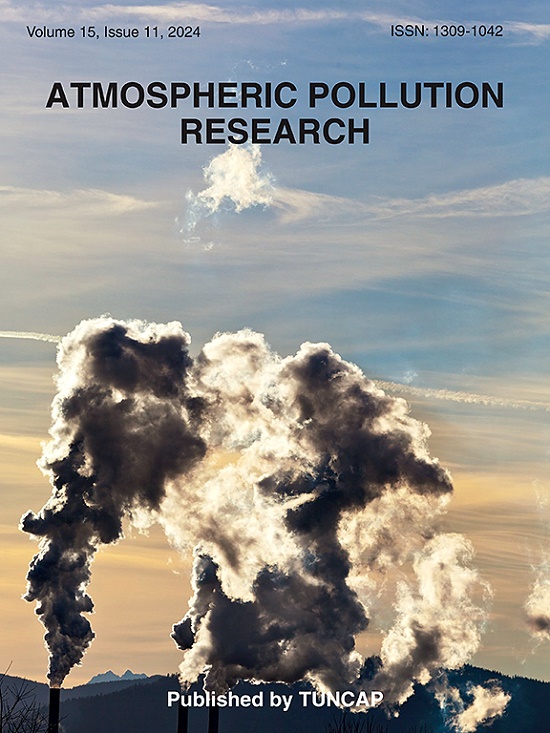土地利用与气象因素对PM2.5浓度空间分布特征的影响研究
IF 3.9
3区 环境科学与生态学
Q2 ENVIRONMENTAL SCIENCES
引用次数: 0
摘要
准确捕捉细颗粒物(PM2.5)的空间分布特征是大气污染防治的关键。研究表明,PM2.5浓度受气象因素和城市土地利用的共同影响。本研究综合考虑了这些因素,并将土地覆盖、气象和道路交通作为潜在的自变量。利用土地利用回归(LUR)模型识别不同土地利用类型对PM2.5浓度空间分布的主要影响因素,并利用随机森林(RF)模型评价这些影响因素的重要性。研究结果表明:(1)居住和工业用地PM2.5浓度波动较为剧烈,波动范围在0 ~ 50 μg/m3之间;商业和公共服务用地的变化范围为0 ~ 40 μg/m3。(2)居住用地PM2.5浓度分布主要受降水和相对湿度影响,相对重要性分别为36.3%和23.9%。在工业用地中,主要受风速的影响,相对重要性为30.6%。(3)对PM2.5浓度空间分布影响最大的决定因素是气象因子,其相对重要性超过62%。道路交通的相对重要性在15.6%至24.9%之间。土地覆被因子占比为9.9% ~ 22.4%。本研究分析了城市土地利用与PM2.5浓度空间分布之间的耦合关系,并阐述了前者对后者的具体影响。本文章由计算机程序翻译,如有差异,请以英文原文为准。
Research on the impact of land use and meteorological factors on the spatial distribution characteristics of PM2.5 concentration
Precisely capturing the spatial distribution characteristics of fine particulate matter (PM2.5) is the key to air pollution prevention and control. Researches suggests that PM2.5 concentrations is jointly affected by meteorological factors and urban land use. This study comprehensively considered these factors, with land cover, meteorology and road traffic as potential independent variables. The land use regression (LUR) model was used to identify the main influences on the spatial distribution of PM2.5 concentration under different types of land use, and the importance of these factors was assessed using a random forest (RF) model. The research findings indicate that: (1) The fluctuations of PM2.5 concentration in residential and industrial land use are relatively severe, ranging from 0 to 50 μg/m3. The changes in commercial and public service land use range from 0 to 40 μg/m3. And the in green space range from 15 to 33 μg/m3 (2) The distribution of PM2.5 concentration in residential land is primarily influenced by precipitation and relative humidity, with relative importance of 36.3% and 23.9%, respectively. And that in industrial land use is primarily influenced by wind speed, with a relative importance of 30.6%. (3) The most influential determinant of spatial distribution of PM2.5 concentration is meteorological factors, with relative importance exceeding 62%. The relative importance of road traffic ranges from 15.6% to 24.9%. And that of land cover factors ranges from 9.9% to 22.4%. This study analyzes the coupling connection between urban land use and spatial distribution of PM2.5 concentration, and elaborates the specific influence of the former on the latter.
求助全文
通过发布文献求助,成功后即可免费获取论文全文。
去求助
来源期刊

Atmospheric Pollution Research
ENVIRONMENTAL SCIENCES-
CiteScore
8.30
自引率
6.70%
发文量
256
审稿时长
36 days
期刊介绍:
Atmospheric Pollution Research (APR) is an international journal designed for the publication of articles on air pollution. Papers should present novel experimental results, theory and modeling of air pollution on local, regional, or global scales. Areas covered are research on inorganic, organic, and persistent organic air pollutants, air quality monitoring, air quality management, atmospheric dispersion and transport, air-surface (soil, water, and vegetation) exchange of pollutants, dry and wet deposition, indoor air quality, exposure assessment, health effects, satellite measurements, natural emissions, atmospheric chemistry, greenhouse gases, and effects on climate change.
 求助内容:
求助内容: 应助结果提醒方式:
应助结果提醒方式:


